Lakhmir Singh Chemistry Text Book Page No – 56
Solution 01
False
Solution 02
Milk, Paint, Glass
Solution 03
Air is a mixture.
Solution 04
Mercury is a liquid metal and bromine is a liquid non-metal.
Solution 05
Sodium metal is soft and diamond is an extremely hard non-metal.
Solution 06
Diamond is a non-metal which is good conductor of electricity.
Solution 07
Mercury
Solution 08
Carbon is a solid non-metal, bromine is a liquid non-metal and chlorine is a gaseous non-metal.
Solution 09
(a). Malleability
(b). Ductility
Solution 10
Non-metals show brittleness.
Solution 11
This means that metals can be drawn into thin sheets and can also be drawn into wires.
Solution 12
This means that non-metals break into pieces when they are hammered.
Solution 13
This means that metals make a ringing sound when we strike them.
Solution 14
This means that metals are shiny in nature.
Solution 15
Mixtures.
Lakhmir Singh Chemistry Text Book Page No – 57
Solution 16
The given statement best describes a compound.
Solution 17
Copper is an element, water is a compound and air is a mixture.
Solution 18
Mixtures are generally heterogeneous in which there is a boundary separation between different substituents.
Solutions are homogeneous mixtures in which no separation is visible between different materials.
Solution 19
Metalloids
Solution 20
(a).An element is made up of only one kind of atoms.
(b).Brine is a mixture whereas alcohol is a compound.
(c).Brass is an alloy which is considered a mixture.
(d).The three important metalloids are boron ,silicon and germanium.
(e).The elements which are sonorous are called metals.
Solution 21
(i). H2O – Compound
(ii). He – Element
(iii). Cl2 – Element
(iv). CO – Compound
(v). Co – Element
Solution 22
Elements – Iron, Sulphur, Sodium and Carbon
Compounds – Iron sulphide, Chalk, Washing Soda and Urea
Solution 23
Sugar contains carbon, hydrogen and oxygen.
Common salt contains sodium and chlorine.
Solution 24
A pure substance is one which is made up of only one kind of atoms or molecules.
Examples – Oxygen and sugar.
Solution 25
Two types of pure substances –
(i). Pure substance made up of same kind of atoms.
Example – Sulphur
(ii). Pure substance made up of same kind of molecules.
Example – Water
Solution 26
Ice, iron, hydrochloric acid, calcium oxide and mercury are the pure substances
Solution 27
Mixture is another name for impure substances.
Examples – Milk and sea-water.
Solution 28
Elements: Mercury, Iron, Diamond, Nitrogen, Graphite, Hydrogen, Oxygen and chlorine.
Solution 29
Air is a mixture because-
(i). Air can be separated into its constituents like oxygen, nitrogen, etc. by physical process of fractional distillation.
(ii). Air shows the properties of all the gases present in it.
(iii). Liquid air does not have a fixed boiling point.
Water is compound because –
(i). Water cannot be separated into its constituents, hydrogen and oxygen by physical methods.
(ii). Heat and light are given out when water is prepared by burning hydrogen in oxygen.
(iii). Water has standard b.p. of 100oC under standard atmospheric pressure.
Solution 30
Two solid elements at room temp. – Iron and copper
Two liquid elements at room temp. – Mercury and bromine
Two gaseous elements at room temp. – Hydrogen and oxygen
Solution 31
Hydrogen and oxygen cannot be split up into two or more simpler substances by applying heat, light or electric energy.
Whereas, water can be split up into hydrogen and oxygen by applying electric energy, so it is not an element.
Solution 32
All the elements can be divided into following three groups-
(i). Metals ; Iron and copper
(ii).Non-metals ; Carbon and sulphur
(iii).Metalloids ; Boron and silicon
Solution 33
Metals are malleable and ductile whereas non-metals are not.
Solution 34
(i). Malleability – Metals show this property but non-metals don’t.
(ii). Ductility – Metals show this property but non-metals don’t.
(iii). Electrical conductivity – Metals are good conductors of electricity whereas non-metals are bad conductors except graphite.
Solution 35
Aluminium is malleable, ductile and sonorous, so it is a metal.
Solution 36
(a). Copper is ductile so it is used for making wires.
(b). Graphite is the only non-metal which conducts electricity so it can be used to make electrodes.
Solution 37
We can check this by evaporating the given colourless liquid.
If nothing is left behind then the colourless liquid is pure water.
Solution 38
Sea-water and Soda-water.
Solution 39
Air is a mixture because-
(i). Air can be separated into its constituents like oxygen, nitrogen, etc. by physical process of fractional distillation.
(ii). Air shows the properties of all the gases present in it.
(iii). Liquid air does not have a fixed boiling point.
Solution 40
Water is a compound because –
(i). Water cannot be separated into its constituents, hydrogen and oxygen by physical methods.
(ii). Heat and light are given out when water is prepared by burning hydrogen in oxygen.
Solution 41
A compound is a substance made up of two or more elements chemically combined in a fixed proportion by mass.
NaCl cannot be separated into its constituents by physical process and the properties of NaCl is completely different from that of Na and Cl, so NaCl is a compound and not a mixture.
Solution 42
A mixture is a substance which consists of two or more elements or compounds not chemically combined together.
As energy is neither evolved nor absorbed during the formation of sugar solution and a sugar solution shows properties of both sugar and water so sugar solution is a mixture not a compound.
Solution 43
Brass is a mixture because-
(i). It shows the properties of its constituents, copper and zinc.
(ii). It has a variable composition.
Solution 44
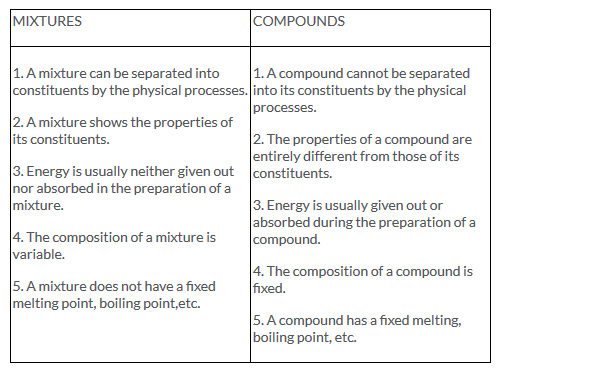
Solution 45
As energy is neither evolved nor absorbed during the formation of salt solution and a salt solution shows properties of both salt and water so salt solution is a mixture not a compound.
Lakhmir Singh Chemistry Text Book PAGE No 58
Solution 46
Similarity: In both the cases, the mixture can be separated into their constituents by physical methods.
Difference: No separation is visible in the mixture of sugar and water whereas separation is visible in mixture of sand and sand.
Solution 47
Evaporate both the liquids separately.
A pure compound will evaporate completely, leaving no residue whereas solution will not be evaporated completely, i.e. some residue will be left behind.
Solution 48
(a). Iodine is a lustrous non-metal.
(b). Oxygen is a non-metal required for combustion.
(c). Allotrope of carbon forms good conductor of electricity.
That allotrope is graphite.
(d). Silicon
(e). Carbon
Solution 49
(a). Sodium
(b). Mercury
(c). Mercury
(d). Sodium
(e). Gold
Solution 50
Chlorine gas, Aluminium foil, Iodine vapour, Graphite, Sulphur powder, Diamond are not compounds.
Solution 51
(a). Those mixtures in which the substances are completely mixed together and are indistinguishable from one another, are called homogeneous mixtures. They have a uniform composition throughout its mass. All the homogeneous mixtures are called solutions.
Examples- Sugar solution, salt solution, copper sulphate solution, etc.
Those mixtures in which the substances remain separate and one substance is spread throughout the other substance as small particles, droplets or bubbles, are called heterogeneous mixtures. Heterogeneous mixture does not have a uniform composition throughout its mass.
Example- Starch solution, soap solution.
(b). Homogeneous mixtures – Soda water, air, vinegar, alcohol and water mixture, sugar and water mixture, Copper sulphate solution.
Heterogeneous mixture – Wood, petrol and water mixture, chalk and water mixture.
Solution 52
(a).(i).Elements – An element is a substance which cannot be split up into two or more simpler substances by the usual chemical methods of applying heat, light or electricity.
Ex. Hydrogen, Oxygen
(ii). Compounds – A compound is a substance made up of two or more elements chemically combined in a fixed proportion by mass.
Ex. Sodium chloride, calcium carbonate
(iii). Mixtures – A mixture is a substance which consists of two or more elements or compounds not chemically combined together.
(b). Elements – Gold, Diamond, Graphite
Compounds – Common salt, Sea water, Marble
Mixtures – Brass, Sand, Petroleum, Chalk, Air
Solution 53
(i). METALS – A metal is an element that is malleable, ductile and conducts electricity.
Example – Iron, Copper
(ii). NON-METALS – A non metal is an element that is neither malleable, nor ductile and does not conducts electricity.
Example – Carbon, Sulphur
(iii). METALLOIDS – The elements which show some properties of metals and some other properties of non-metals are called metalloids.
Example – Boron, Silicon, Helium, Magnesium, Copper
(b). Metals – Mercury, Sodium,
Non-metals – Diamond, Sulphur, Iodine, Carbon, Boron
Metalloids – Silicon, Germanium
Solution 54
(a). Mixtures – A mixture is a substance which consists of two or more elements or compounds not chemically combined together.
Examples – Air, gun powder.
(b). Homogeneous mixtures- Those mixtures in which the substance are completely mixed together and are indistinguishable from one another, are called homogeneous mixtures.
Examples- Sugar solution, copper sulphate solution.
Those mixtures in which the substances remain separate and one substance is spread throughout the other substance as small particles, droplets or bubbles, are called heterogeneous mixtures.
Example- Starch solution, soap solution.
(c). Other name for homogeneous mixtures is SOLUTIONS.
Solution 55
(a). Three general classes of matter are elements, compounds and mixtures.
Element – Hydrogen
Compound – Sodium chloride
Mixtures – Salt solution
(b).
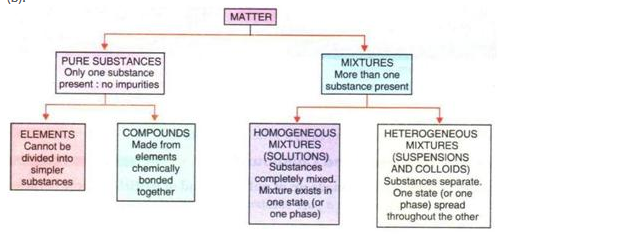
Lakhmir Singh Chemistry Text Book PAGE No 59
Solution 71
Steam does not belong to the set. This is because all other are elements while steam is a compound.
Solution 72
(a). B is a mixture (Fe + S)
(b). C is a compound (Iron sulphide)
(c). (i). D is hydrogen sulphide gas
(ii). E is hydrogen gas
(d). Gas D has a rotten egg like smell.
(e). Gas E burns with a ‘pop’ sound.
Lakhmir Singh Chemistry Text Book Page No: 60
Solution 73
(a). X must be a mixture. Salt solution is a substance like X.
(b). Y must be an element. Oxygen is a substance like Y.
(c). Z must be a compound. Water is a substance like Z.
(d). Formation of Z (a compound) involves absorption or release of an appreciable amount of energy.
(e). The three groups are metals, non-metals and metalloids.
Solution 74
(a). Group of materials P is elements.
(b). Q is a non-metal. Example – Carbon and sulphur.
(c). R is a metal. Example – Copper and Aluminium.
(d). S is a metalloid. Example – Boron and Silicon.
(e). R (metals) are malleable and ductile.
Solution 75
(a). B could be an element. It is mercury.
(b). C could be the mixture. It is a salt solution.
(c). A could be a compound. It is an alcohol.
(d). Solid D is Sodium Chloride.
(e). Liquid E is water.
Lakhmir Singh Chemistry Text Book Page No 79
Solution 1
(a)Solution
(b)Suspension
Solution 2
Solution
Solution 3
Soap solution will scatter light because in true solution i.e. sugar solution, the solute particles are so small that they cannot scatter light rays while in soap solution particles are big enough to scatter light.
Solution 4
Heterogeneous
Solution 5
Percentage method
Solution 6
Mass of water = Mass of solution – Mass of salt (solute)
= 100 – 15 = 85 g
Solution 7
![]()
So, Volume of solution = 100 ml
Volume of water = Volume of solution – Volume of solute (alcohol)
= 100 – 12 = 88 ml
Solution 8
(a)
A 5 per cent sugar solution means that 5g of sugar is dissolved in 95 g of water.
Solution 9
(a)
A 15% alcohol solution means 15mL alcohol and 85mL water
Solution 10

Solution 11
Given mass of urea = 16 g
And, mass of solution = 120 g
So,

Solution 12
Given volume of alcohol = 5.6 mL
And, volume of water = 75 mL
So, volume of solution = 75 mL + 5.6 mL = 80.6 mL

Solution 13
Given volume of acetone = 25 mL
And, volume of solution = 150 mL

Solution 14
When the temperature of a saturated sugar solution is increased, it becomes unsaturated.
Solution 15
Unsaturated solution contains less solute at a given temperature and pressure.
Solution 16
Physical change-Vaporisation(water changes to water vapour or steam)
Chemical change-Electrolysis(i.e.water forms hydrogen and oxygen)
Solution 17
(a)True
(b)False
Lakhmir Singh Chemistry Text Book PAGE NO 80
Solution 18
Colloid
Solution 19
Soap solution
Solution 20
(a) Colloidal; true
(b) Heterogeneous; centrifugation
Solution 21
(a)Solute-The substance which is dissolved in a liquid to make a solution is called as solute.
(b)Solvent-The liquid in which solute is dissolved is known as solvent.
Solution 22
A solution is a homogeneous mixture of two or more substances whereas a colloid is a kind of solution in which the size of solute particles is intermediate between those in true solutions and those in suspensions.
Solution 23
A colloid is a kind of solution in which the size of solute particles is intermediate between those in true solutions and those in suspensions whereas a suspension is a heterogeneous mixture in which the small particles of a solid are spread throughout a liquid without dissolving in it.
Solution 24
A true solution does not scatter a beam of light passing through it but a colloidal solution scatters a beam of light passing through it and renders its path visible. A true solution is a homogeneous mixture of two or more substances whereas a colloidal solution is a kind of solution in which the size of solute particles is intermediate between those in true solutions and those in suspensions and is a heterogeneous mixture.
Solution 25
True Solutions – Salt solution and sugar solution
Colloidal Solution – Starch solution, Ink, Blood
Solution 26
The given solution is taken in a beaker. Then, a strong beam of light is allowed to fall on the solution from one side of the beaker in a dark room. If the beam of light is visible in the solution, then it is a colloidal solution.
Solution 27
The path of light beam is illuminated and becomes visible.
Solution 28
A true solution can be distinguished from a colloidal solution by experimenting Tyndall effect. A true solution does not scatter a beam of light passing through it but a colloidal solution scatters a beam of light passing through it.
Solution 29
The particles of a suspension cannot pass through a filter paper whereas particles of colloids can easily pass through filter paper.
Colloidal solutions are quite stable whereas suspensions are very unstable.
Solution 30
Both the given solutions will be kept stationary in different beakers for some time.
The beaker in which the dissolved particles settle down after some time is a suspension and another one is a solution.
Solution 31
Starch solution and milk will show Tyndall effect.
This is because in a milk solution and starch solution (colloidal solutions) the size of solute particles is big enough to scatter the light passing through it.
Solution 32
Types of solution-
(i). Solid in solid.
Example- Brass
(ii). Solid in a liquid
Example- Tincture of iodine
(iii). Liquid in liquid
Example- ethanoic acid
(iv). Gas in a liquid
Example- CO2 in water
(v). gas in gas
Example- Air
Solution 33
Solutions – Brine
Suspensions – Chalk water mixture, milk of magnesia, Muddy river water
Colloids – Milk, blood, ink, shaving cream, smoke in air, soda water
Solution 34
(a). Sol – Sol is a colloid in which tiny solid particles are dispersed in a liquid medium. Examples are ink and soap solution
(b). Aerosol- Aerosol is a colloid in which a solid or liquid is dispersed in a gas. Examples are hairspray and fog.
(c). Emulsion – An emulsion is a colloid in which minute droplets of one liquid are dispersed in another liquid which is not miscible with it. Examples are milk and butter.
(d). Foam- A foam is a colloid in which a gas is dispersed in a liquid medium. Examples are soap bubbles and shaving cream.
Solution 35
The concentration of a solution is the amount of solute present in given quantity of the solution.
Solution 36
If a saturated solution is heated to a higher temperature, then it becomes unsaturated.
If a saturated solution is cooled to a lower temperature, then some of its dissolved solute will separate out in the form of solid crystals.
Solution 37
According to question-
21.5 g of NaCl dissolves in 60 g of water.
So, amount of NaCl which gets dissolved in 100 g of water = 21.5 x 100 / 60 = 35.8 g
Thus, the solubility of NaCl is 35.8 g at 25oC.
Solution 38
According to question-
9.72 g of KCl dissolves in 30 g of water.
So, amount of KCl which gets dissolved in 100 g of water = 9.72 x 100/30 = 32.4 g
Thus, the solubility of KCl = 32.4 g
Solution 39
i. Cooking of food – Chemical change
ii. Boiling of water – Physical change
iii. Cutting of trees – Physical change
iv. Dissolving salt in water – Physical change
v. Digestion of food – Chemical change
vi. Melting of ice- Physical change
Solution 40
(a) Burning of magnesium wire – Chemical change
(b) Freezing of water – Physical change
(c) Rusting of iron – Chemical change
(d) Glowing of electric bulb – Physical change
Solution 41
(a) Formation of curd from milk – Chemical chang
(b) Condensation of steam – Physical change
(c) Growth of plant – Chemical change
(d) Breaking of a glass tumbler – Physical change
Lakhmir Singh Chemistry Text Book PAGE No 81
Solution 42
Physical change – Sublimation of solid, Formation of clouds, making of fruit salad from raw fruits, dissolving CO2 in water
Chemical change – Decomposition of water into H2 and O2 by passing electric current
Solution 43
Physical change – Melting of candle wax, mixing of iron filings and sand, breaking a piece of chalk, cutting a piece of paper
Chemical change – Burning of candle wax, burning of wood, burning of piece of paper
Solution 44
When sea water is a mixture of dissolved salts and water only, it is homogeneous solution.
And if sea water contains suspended impurities like decayed plants or animal material, etc. then it is called heterogeneous solution.
Solution 45
Sugar solution, Salt solution, copper sulphate solution and ammonium chloride solution do not show Tyndall effect.
Solution 46
(a). The change in which no new substance is formed is called a physical change.
Example- Melting of candle wax, mixing of iron filings and sand
(b).The change in which new substance is formed is called a chemical change.
Example- Burning of candle wax, burning of wood
Solution 47

(b). Chemical change – Coal burning in air, making of cake
Physical change- A glass bottle breaking, wool being knitted into a sweater.
Solution 48
(a). The maximum amount of a solute which can be dissolved in 100 g of a solvent at a specified temperature is known as the solubility of that solute in that solvent .
The solubility of solids in liquids is directly proportional to temperature whereas the solubility of gases in liquids is inversly proportional to temperature.
(b). This statement means that 100 g of water can dissolve a maximum of 20.7 g of copper sulphate at 20oC.
(c). The solubility of solids in liquids increases on increasing the temperature and decreases on decreasing the temperature.
Solution 49
(a). A solution is a homogeneous mixture of two or more substances.
Example- Salt solution, metal alloys.
(b). A suspension is a heterogeneous mixture in which the small particles of a solid are spread throughout a liquid without dissolving in it.
Example- Muddy-water, Milk of magnesia.
(c). A colloid is a kind of solution in which the size of solute particles is intermediate between those in true solutions and those in suspensions.
Example- Soap solution, milk.
Solution 50
(a). A solution in which no more solute can be dissolved at that temperature is called a saturated solution while a solution in which more quantity of solute can be dissolved without raising its temperature is called an unsaturated solution.
To test the saturation or unsaturation of a solution, more solute may be added to the solution. If that solute gets dissolved in the solution then the solution will be unsaturated.
To test whether a given solution is saturated or not, add some more solute to the solution and try to dissolve it by stirring. If solute does not dissolve in the given solution, then it will be a saturated solution.
(b). Take some water in a beaker and heat it slowly with the help of burner. Now, start adding sodium chloride salt to the hot water with a spoon and stir it with a glass rod continuously so that sodium chloride goes on dissolving in water. Take the temperature of water up to 25oC and then keeping this temperature constant, go on adding sodium chloride till no more sodium chloride dissolves in it and some undissolved crystals will be left at the bottom. The contents of the beaker are now filtered and the clear solution obtained is the saturated solution of sodium chloride at 25oC.
If the temperature is lowered from 25oC to 10oC, then some of the crystals of sodium chloride will separate out from the solution in the form of solute crystals.
Lakhmir Singh Chemistry Text Book PAGE N0 82
Solution 66
Indigestion mixtures are suspensions so there is an instruction written on the bottle of these mixtures “SHAKE IT WELL BEFORE USE”. This is because the particles of indigestion mixture i.e. suspensions are unstable and settle down at the bottom of the bottle after some time.
Solution 67
(a) Mixtures like A are known as suspensions.
(b) Mixtures like B are known as colloids.
(c) Mixtures like C are known as true solutions.
(d) The phenomenon existed by A and B which occurs on passing a beam of light through them is called Tyndall effect.
(e) (i) Chalk-water mixture is like A.
(ii) Soap solution is a mixture like B.
(iii) Salt solution is a mixture like C.
Solution 68
(a) When solid A is dissolved in water, chemical change takes place. This is because the properties of products B and C are entirely different from those of solid A and water and a lot of heat and energy is evolved in the reaction.
(b) Physical change occurs when solid D is dissolved in water. This is because the product E shows the properties of both, solid D and water.
(c) Sodium metal could behave like solid A.
Product B is sodium hydroxide.
Product C is hydrogen.
(d) Solid D is ammonium chloride.
(e) D can be recovered from E by evaporation.
Solution 69
(a) Solution like X are known as unsaturated solution.
(b) Solution like Y are known as saturated solution.
(c) If solution Y at 30oC is cool down to 10oC by keeping the beaker in crushed ice, then some of the dissolved solid will separate out from the solution and settle at the bottom of the beaker as crystals. This is because the solubility of solid decreases on cooling.
(d) Solubility is the term used to denote the amount of solid dissolved in 100 grams of water in a solution.
PAGE NO 83
Solution 70
According to question:
Solubility at 40oC = 41 g
But, solubility = solid dissolved in 100 grams of water in a solution
So, mass of ammonium chloride needed to make a saturated solution of ammonium chloride in 50 g of water at 40oC= 41/2 g = 20.5 g
Lakhmir Singh Chemistry Text Book PAGE NO 105
Solution 1
Carbon disulphide
Solution 2
Sublimation
Solution 3
Sublimation
Solution 4
Sublimation
Solution 5
Camphor undergoes sublimation.
Solution 6
Electromagnet.
Solution 7
Iodine undergoes sublimation.
Solution 8
Fractional distillation
Solution 9
Difference in their boiling point.
Solution 10
Acetone and water
Solution 11
Kerosene and water.
Solution 12
(a)False
(b)False
Solution 13
Air
Solution 14
Fractional distillation of liquid air.
Solution 15
He should choose magnetic separation method to separate iron nails from saw-dust.
Solution 16
Salt and camphor.
Solution 17
Mixture of common salt and water.
Solution 18
By filtration.
Solution 19
Filtration
Solution 20
Evaporation
Solution 21
Centrifugation
Solution 22
Centrifugation is used to separate cream from milk.
Solution 23
Filtration
Solution 24
Fractional distillation
Solution 25
Separating funnel
Solution 26
Difference in the densities of oil and water enable their separation by a separating funnel.
Solution 27
(a)Evaporation
(b)Crystallization
Solution 28
Crystallization
Solution 29
(a) Evaporation
(b) Paper chromatography
Lakhmir Singh Chemistry Text Book PAGE No 106
Solution 30
Centrifugation
Solution 31
Chromatography
Solution 32
(a) Fractional distillation
(b) Separating funnel
(c) Fractional distillation
(d) Boiling points
(e) Boiling points
(f) Centrifugation
(g) Magnet
Solution 33
Sugar is soluble in water whereas sand is insoluble in water. The difference in their solubility is used to separate them. The mixture of sand and sugar is dissolved in water, then it is filtered with the help of filter paper. Sand remains as residue on the filter paper while sugar solution is obtained as filtrate.The filtrate is then evaporated to get crystals of sugar.
Solution 34
The difference in the solubility of salt and sand in water is used to separate them from their mixture.
Solution 35
Salt is soluble in water whereas sand is insoluble in water. The difference in their solubility is used to separate them. The mixture of sand and salt is dissolved in water, then it is filtered with the help of filter paper. Sand remains as residue on the filter paper while salt solution is obtained as filtrate .The filtrate is then evaporated to get crystals of salt.
Solution 36
Sugar is soluble in alcohol but salt is insoluble in alcohol, so a mixture of sugar and salt can be separated by using alcohol as solvent.
Solution 37
Sodium chloride is soluble in water whereas sand is insoluble in water. The difference in their solubility is used to separate them. The mixture of sand and sodium chloride is dissolved in water, then it is filtered with the help of filter paper. Sand remains as residue on the filter paper while sodium chloride solution is obtained as filtrate .The filtrate is then evaporated to get crystals of sodium chloride.
Solution 38
Potash alum is soluble in water whereas sand is insoluble in water. The difference in their solubility is used to separate them. The mixture of sand and potash alum is dissolved in water, then it is filtered with the help of filter paper. Sand remains as residue on the filter paper while potash alum solution is obtained as filtrate .The filtrate is then evaporated to get crystals of potash alum.
Solution 39
Sulphur is soluble in carbon disulphide whereas sodium chloride is insoluble in carbon disulphide.The mixture of sulphur and sodium chloride is shaken with carbon disulphide.Sulphur dissolves in carbon disulphide whereas sodium chloride remains undissolved. The solution is then filtered,sodium chloride is obtained as residue.On evaporating the filtrate ,carbon disulphide solvent is eliminated and solid sulphur remains behind.
Solution 40
Mixture of iodine and common salt is heated. Iodine sublimes on heating leaving behind common salt and can be recovered in the form of sublimate by cooling its vapours.
Solution 41
Mixture of camphor and sand is heated. Camphor sublimes on heating leaving behind sand and can be recovered in the form of sublimate by cooling its vapours.
Solution 42
Mixture of iron filings and powdered carbon can be separated by using magnet.A horse-shoe magnet is moved on the surface of the mixture.The iron filings are attracted by the magnet,they cling to the poles of the magnet and get separated. This process is repeated a number of times till complete separation of iron filings is done.
Solution 43
Mixture of iron filings and powdered carbon can be separated by using magnet.A horse-shoe magnet is moved on the surface of the mixture.The iron filings are attracted by the magnet,they cling to the poles of the magnet and get separated. This process is repeated a number of times till complete separation of iron filings is done.
Solution 44
In factories, scrap iron is separated from the heap of waste materials by using big electromagnets fitted to a crane.When a crane fitted with a powerful electromagnet is lowered on to the heap of waste materials, then the scrap iron objects present in the heap cling to the electromagnet. The crane is then moved up and away to drop these scrap iron objects at a separate place.
Solution 45
In industries, the impurity of iron present in several substances is removed by the use of magnets. Iron objects stick to the magnet leaving behind other objects.
Solution 46
Mixture of iron pins and sand can be separated by using magnet.A horse-shoe magnet is moved on the surface of the mixture.The iron pins are attracted by the magnet,they cling to the poles of the magnet and get separated. This process is repeated a number of times till complete separation of iron pins is achieved.
Solution 47
At first, the mixture of common salt, sulphur powder and sand is shaken with carbon disulphide. Sulphur dissolves in carbon disulphide whereas common salt and sand remain undissolved. The solution is then filtered, common salt and sand mixture is obtained as residue. On evaporating the filtrate, carbon disulphide solvent is eliminated and solid sulphur remains behind. Now, the common salt and sand mixture is shaken with water. Common salt gets dissolved in water .The solution is then filtered, sand is obtained as residue. The filtrate is then evaporated to get crystals of common salt.
Solution 48
The mixture of water, kerosene and sand is filtered with the help of filter paper first. Sand remains as residue on the filter paper while mixture of water and kerosene is obtained as filtrate .The mixture of water and kerosene is then put in separating funnel and allowed to stand for sometime. The mixture separates into two layers according to the difference in the densities of water and kerosene. Water is heavier than kerosene. So,water forms lower layer while kerosene forms upper layer.On opening the stop clock of separating funnel,the lower layer of water comes out first and collected in beaker leaving behind kerosene in the separating funnel.
Solution 49
The mixture of common salt,sand and ammonium chloride will be heated first.Ammonium chloride sublimes on heating and can be recovered in the form of sublimate by cooling its vapours leaving behind mixture of common salt and sand.Salt is soluble in water whereas sand is insoluble in water.The mixture of sand and salt is dissolved in water, then it is filtered with the help of filter paper. Sand remains as residue on the filter paper while salt solution is obtained as filtrate .The filtrate is then evaporated to get crystals of salt.
Solution 50
A horse-shoe magnet is moved on the surface of the mixture of camphor,common salt and iron nails.The iron nails are attracted by the magnet, they cling to the poles of the magnet and get separated. This process is repeated a number of times till complete separation of iron nails occur leaving behind mixture of camphor and common salt. Mixture of camphor and common salt is heated. Camphor sublimes on heating leaving behind common salt and can be recovered in the form of sublimate by cooling its vapours
Solution 51
The mixture of water, groundnut oil and common salt is put in a separating funnel and allowed to stand for sometime. The mixture separates into two layers according to the densities of water and groundnut oil. Water is heavier than groundnut oil. So, water forms lower layer while groundnut oil forms upper layer. On opening the stop clock of separating funnel, the lower layer of water comes out first and collected in beaker leaving behind groundnut oil in the funel. Now, solution of water and common salt is heated. Water gets evaporated leaving behind solid common salt.
Solution 52
Mixture of chalk powder,iron filings and naphthalene can be separated by using magnet and then by sublimation. A horse-shoe magnet is moved on the surface of the mixture.The iron filings are attracted by the magnet, they cling to the poles of the magnet and get separated. This process is repeated a number of times till complete separation of iron filings occur leaving behind mixture of chalk powder and naphthalene. Then, mixture of chalk powder and naphthalene is heated.Naphthalene sublimes on heating leaving behind chalk powder and can be recovered in the form of sublimate by cooling its vapours.
Solution 53
Mixture of iodine, iron filings and salt can be separated by using magnet and then by sublimation. A horse-shoe magnet is moved on the surface of the mixture.The iron filings are attracted by the magnet, they cling to the poles of the magnet and get separated. This process is repeated a number of times till complete separation of iron filings occur leaving behind mixture of iodine and salt. Then, mixture of iodine and salt is heated. Iodine sublimes on heating leaving behind salt and can be recovered in the form of sublimate by cooling its vapours.
Solution 54
Mixture of iron filings,chalk powder and common salt can be separated by using magnet first.A horse-shoe magnet is moved on the surface of the mixture.The iron filings are attracted by the magnet,they cling to the poles of the magnet and get separated. This process is repeated a number of times till complete separation of iron filings occur leaving behind mixture of chalk powder and common salt.The mixture of chalk powder and common salt is then dissolved in water and then filtered with the help of filter paper. Chalk powder remains as residue on the filter paper while common salt solution is obtained as filtrate .The filtrate is then evaporated to get crystals of common salt.
Solution 55
Mixture of common salt, sand and iron filings can be separated by using magnet first. A horse-shoe magnet is moved on the surface of the mixture. The iron filings are attracted by the magnet, they cling to the poles of the magnet and get separated. This process is repeated a number of times till complete separation of iron filings occur leaving behind mixture of common salt and sand.The mixture of common salt and sand is then dissolved in water and then filtered with the help of filter paper. Sand remains as residue on the filter paper while common salt solution is obtained as filtrate .The filtrate is then evaporated to get crystals of common salt.
Solution 56
The mixture of water and kerosene is put in separating funnel and allowed to stand for sometime. The mixture separates into two layers according to the densities of water and kerosene. Water is heavier than kerosene.So, water forms lower layer while kerosene forms upper layer. On opening the stop clock of separating funnel, the lower layer of water comes out first and collected in beaker leaving behind kerosene.
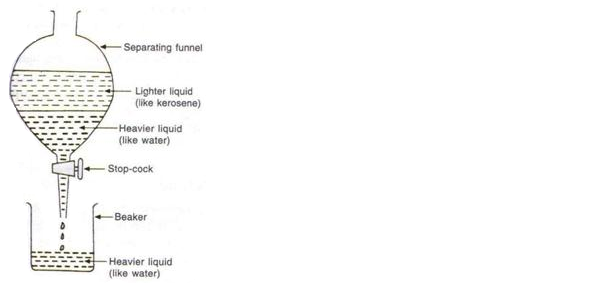
Fig. Separation of kerosene oil and water mixture by separating funnel
Solution 57
The mixture of mustard oil and water is put in separating funnel and allowed to stand for sometime.The mixture separates into two layers according to the densities of water and mustard oil. Water is heavier than mustard oil. So,water forms lower layer while mustard oil forms upper layer. On opening the stop clock of separating funnel, the lower layer of water comes out first and collected in beaker leaving behind mustard oil.
Solution 58
The mixture of cooking oil(groundnut oil) and water is put in separating funnel and allowed to stand for sometime.The mixture separates into two layers according to the densities of water and groundnut oil. Water is heavier than groundnut oil. So,water forms lower layer while groundnut oil forms upper layer. On opening the stop clock of separating funnel,the lower layer of water comes out first and collected in beaker leaving behind groundnut oil.
Solution 59
Mercury, oil and water are immiscible liquids and have different densities. Mixture of mercury, oil and water will be put in separating funnel and allowed to stand for sometimes. The mixture separates into three layers according to the densities of mercury, oil and water. On opening the stop clock of separating funnel, the lower layer formed by mercury comes out first and collected in beaker leaving behind other two layers. Similarly, again on opening the stop clock of separating funnel, the lower layer of water comes out first and collected in beaker leaving behind oil in the funnel.
Solution 60
Sulphur is soluble in carbon disulphide whereas iron filing is insoluble in carbon disulphide.The mixture of sulphur and iron filing is shaken with carbon disulphide.Sulphur dissolves in carbon disulphide whereas iron filings remain undissolved. The solution is then filtered, iron filing is obtained as residue.On evaporating the filtrate, carbon disulphide solvent is eliminated and solid sulphur remains behind.
Solution 61
Centrifugation is used to separate cream from milk.Milk is a suspension of tiny droplets of oil in a watery liquid.It is put in closed container in a big centrifuge machine.When machine is switched on,milk is rotated at very high speed in its container.The cream being lighter floats over the skimmed milk and then can be removed.
Solution 62
Impure copper sulphate is dissolved in minimum amount of water in a china dish to make copper sulphate solution. It is then filtered to remove insoluble impurities. Now, copper sulphate solution is heated gently on a water bath to evaporate water and a saturated solution is obtained. Then heating is stopped and saturated solution of copper sulphate is allowed to cool slowly. Crystals of pure copper sulphate will be formed leaving behind impurities. These crystals are then separated and dried.
Solution 63
Crystallisation is better method for recovering sugar from sugar solution than evaporation because-
(a)Sugar decomposes or get charred on heating to dryness during evaporation.There is no such problem in crystallization.
(b)The soluble impurities do not get removed in the process of evaporation. But such impurities get removed in crystallization.
Solution 64
Chromatography is a technique of separating two or more dissolved solids which are present in a solution in very small quantities.Its two applications are-
(a)Chromatography is used to separate solutions of coloured substances(dyes and pigments).
(b)Chromatography is used to separate small amounts of products of chemical reactions.
Solution 65
(a)Water and kerosene mixture can be separated by using a separating funnel because these are immiscible liquids and they have different densities.
(b)Water and acetone mixture can not be separated by by using a separating funnel because these are miscible liquids.
Lakhmir Singh Chemistry Text Book PAGE NO 107
Solution 66
The mixture of common salt and ammonium chloride is taken in a china dish and placed on a tripod stand. The china dish is covered with an inverted glass funnel. A loose cotton plug is put in the upper, open end of the funnel to prevent the ammonium chloride vapours from escaping into the atmosphere. The china dish is heated by using a burner. On heating the mixture, ammonium chloride changes into white vapours. These vapours rise up and get converted into solid ammonium chloride on coming in contact with the cold, inner walls of the funnel. In this way, pure ammonium chloride collects on the inner sides of the funnel in the form of a sublimate and can be removed. Common salt does not change into vapours on heating, so it remains behind in the china dish and can be separated out.
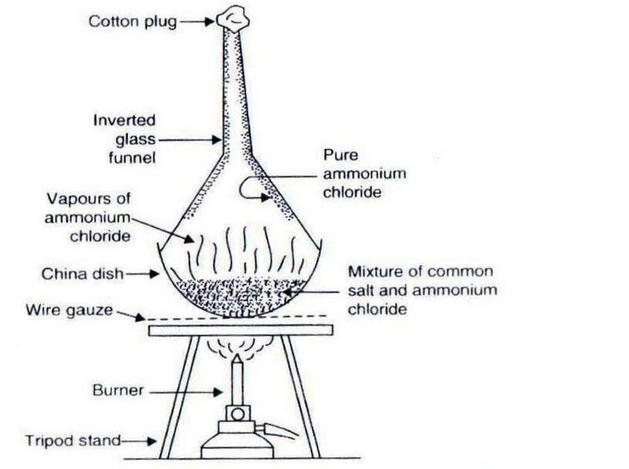
Fig. Separation of mixture of common salt and ammonium chloride by sublimation
Ammonium chloride sublimes on heating whereas common salt does not sublime on heating. So, we can separate ammonium chloride from a mixture of common salt and ammonium chloride by the process of sublimation.
Solution 67
A mixture of common salt and water can be separated completely by the process of distillation. The distillation can be used to separate a liquid from dissolved non-volatile solids.
The salt water mixture is taken in the distillation flask A and heated. Some porcelain pieces are put in the distillation flask to avoid bumping of the solution due to uneven heating. On heating, water forms vapours which rise up and come out through the side tube B of the distillation flask, and go into water condenser C. Cold water from tap is circulated through the outer tube of condenser for cooling the vapours. The hot vapours get cooled in the condenser to form pure water (i.e. distilled water) which trickles down from the condenser and collects in the beaker D. Since the salt is non-volatile, so it remains behind in the distillation flask.
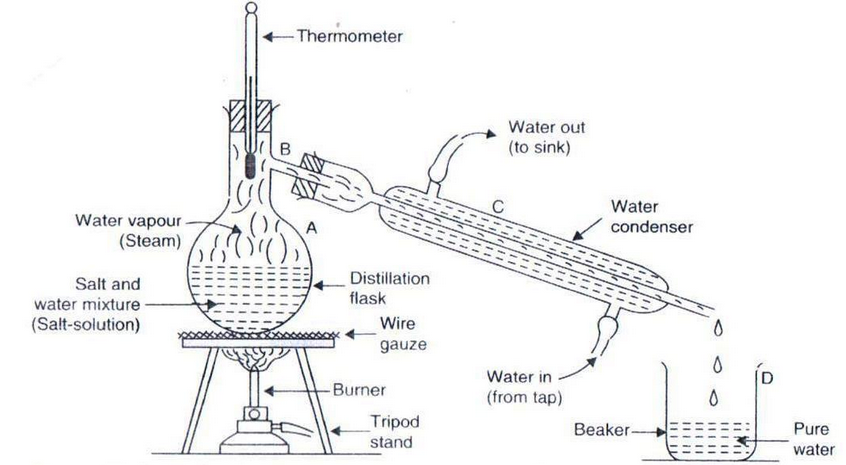
Fig. Separation of mixture of salt and water by distillation
Solution 68
In cities, drinking water is supplied from water works where river or lake water is made free from suspended solid substances and germs. In water works, the methods like sedimentation, decantation, loading, filtration and chlorination etc. are used to remove undesirable materials from water. The source of water supply in a city is either a nearby river or lake (reservoir), from there it is pumped into ‘sedimentation tank’. Here it is allowed to stand for sometime so that many of insoluble substances present in water settle down at bottom of the tank. From there, it is sent to a ‘loading tank’ where some alum is added to water. Here suspended clay particles in water get loaded with alum particles, become heavy and settle down at the bottom of the tank. Then, it is passed through ‘filtration tank’. It has three layers: fine sand layer at top, coarse sand layer in middle and gravel as the bottom layer. These act as filters and even the small suspended particles get removed when water passes through these layers. Then, the clear water is passed into a chlorination tank. Here, chlorine is added to water to kill the germs present in it. Now, the clean and disinfected water is pumped by pumping station into high storage tanks and from there, it is supplied to homes and factories through the network of big and small pipes.
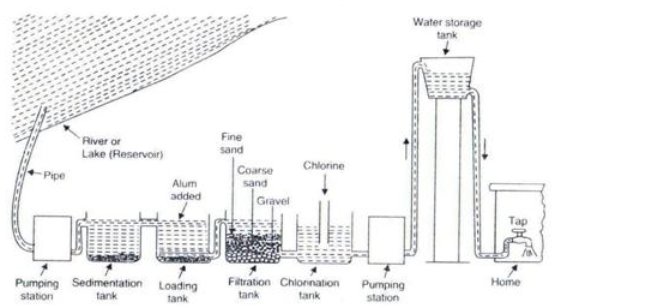
Fig. Water purification process at water works
Solution 69
(a) Fractional distillation is the process of separating two or more miscible liquids (liquids which mix together in all proportions and form a single layer) by distillation, the distillate being collected in fractions boiling at different temperatures. The separation of two liquids by fractional distillation depends on the difference in their boiling points. It is carried out by using a fractionating column.
Fractionating column is a long vertical glass tube filled with glass beads. The glass beads provide a large surface area for hot vapours to cool and condens repeatedly. It provides different temperature zones inside it, the highest temperature being at the bottom of the column and the lowest temperature near its top. It is fitted in the neck of the distillation flask.
(b)
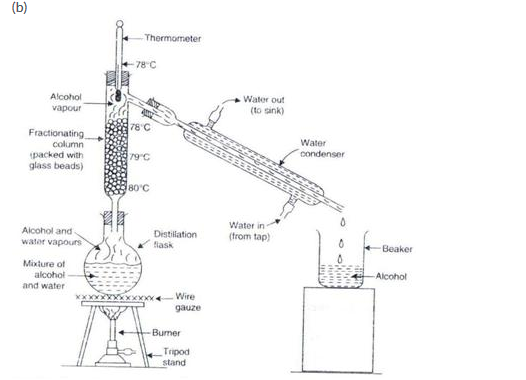
Fig. Separation of mixture of alcohol and water by fractional distillation
Solution 70
(a)Air is mixture of gases like nitrogen, oxygen, argon, carbon dioxide, helium, neon, krypton, xeon etc. The various gases of air are separated from one another by fractional distillation of liquid air. This separation is based on the fact that different gases of air have different boiling points(in liquid form).
The air is first filtered to remove dust, then water vapour and carbon dioxide are removed. Air is compressed to a high pressure and then cooled. The cooled air is then allowed to expand quickly into a chamber through a jet. This cools the air even more. This process of compression, cooling and rapid expansion of air is repeated again and again to make the air more and more cool so that it becomes liquid air. Now, the liquid air is fed into a tall fractionating column and warmed up slowly.
Liquid nitrogen has lowest boiling point of -196oC.So, on warming, it boils off first to form nitrogen gas and is collected at the upper part of the fractional distillation column. Liquid argon has a slightly higher boiling point of -186oC. So, it boils off next and collected as argon gas in the middle part of fractional distillation column. Liquid oxygen has a still higher boiling point of -183 oC. So, liquid oxygen boils off last and collected as oxygen gas at the bottom of fractional distillation column.
(b)
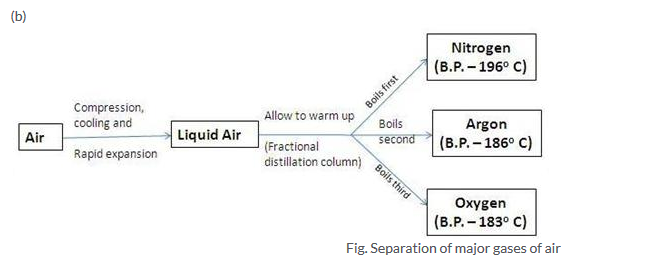
Fig. Separation of major gases of air
Lakhmir Singh Chemistry Text Book PAGE NO 108
Solution 86
(a) Y will be collected from near the bottom of the fractional distillation column because it has highest boiling point of -183oC.
(b) Z will be collected from the top part of the fractional distillation column because it has lowest boiling point of -196oC.
(c) X will be collected from the middle part of the fractional distillation column because it has a boiling point of -186oC which is lower than that of Y but higher than that of Z.
(d) X is liquid argon; Y is liquid oxygen; Z is liquid nitrogen.
Solution 87
(a) We will use fractional distillation to separate a mixture of A and B.
(b) We will use separating funnel to separate a mixture of B and C.
(c) (i) Alcohol would behave like A.
(ii) Water would behave like B.
(iii) Oil would behave like C.
Solution 88
(a) P is sand; Q is common salt; R is iron fillings; S is ammonium chloride.
(b) We first separate R (iron filings) by using a magnet to attract them. Then, separate S (ammonium chloride) by sublimation. Now, we shake P(sand)and Q(common salt) with water and filter. P(sand) is obtained as residue. Now, we evaporate filtrate to dryness to obtain Q(common salt).
Solution 89
(a) X is alcohol.
(b) Y is iodine.
(c) Process Z is called sublimation
(d) Process used to recover both the components alcohol and iodine from tincture of iodine is distillation.
(e) The process used to recover only component Y from tincture of iodine is evaporation.
Solution 90
(a) (i) Constituent A could be sulphur.
(ii) Liquid D could be carbon disulphide.
(b) (i) Constituent B could be copper sulphate.
(ii) Liquid E could be water.
(c) Liquid C could be vegetable oil.
(d) Filter the mixture of A, B and C. C(oil) being liquid will be obtained as a filtrate. Residue consists of A(sulphur) and B(copper sulphate). Add water to the residue mixture, shake and filter. A(sulphur) is obtained as residue. Now, evaporate filtrate to obtain B(copper sulphate).